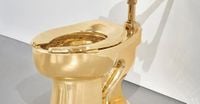In a move that’s sure to spark both admiration and head-scratching, Maurizio Cattelan’s infamous solid gold toilet sculpture, titled America, is set to hit the auction block at Sotheby’s in New York on November 18, 2025. The starting price? A cool $10 million, pegged to the toilet’s current weight in gold—a figure just as dazzling and unpredictable as the artwork itself.
This fully functioning, 220-pound (about 100 kilograms) commode, crafted from 18-karat gold, has been at the center of art world debates, museum queues, political controversy, and even a high-profile heist. Now, as it prepares for its next chapter, the golden throne is temporarily installed in a bathroom at Sotheby’s new home in the Breuer Building on Madison Avenue, where visitors can look but, unlike the piece’s earlier museum outings, not sit. According to CNN and BBC, the auction house is even open to payment in cryptocurrency, a nod to the ever-evolving intersection of art and finance.
But how did a toilet become the darling of the auction season? The journey of America began in 2016, when Cattelan, the Italian conceptual artist known for his provocative works, installed the golden toilet at the Guggenheim Museum in New York. There, more than 100,000 visitors waited in long lines for the unique privilege of relieving themselves atop a solid gold sculpture. The piece’s accessibility—literally open to the public for use—set it apart from the usual look-but-don’t-touch ethos of the art world. As reported by BBC, this was no ordinary pedestal piece: it was a fully plumbed, working toilet, requiring both a security guard and a plumber.
David Galperin, head of contemporary art at Sotheby’s New York, called America a “tour de force.” In his words, “Holding both a proverbial and literal mirror to the art world, the work confronts the most uncomfortable questions about art, and the belief systems held sacred to the institutions of the market and the museum.” He described the sculpture as “a cultural phenomenon” and “an incisive commentary on the collision of artistic production and commodity value.”
The spectacle of America is not just in its material extravagance but in its pointed social commentary. As Artnet observed, the work is reminiscent of Marcel Duchamp’s 1917 Fountain—the urinal that scandalized the art world by declaring the ordinary as art. But Cattelan’s golden toilet, arriving in an era of glaring economic inequality and all-consuming consumerism, ups the ante. It’s a tongue-in-cheek jab at a world where everything, even the most private of objects, can be commodified. The artist himself told The New York Times that his artwork was “the sum of many opposites,” explaining, “It started from something very practical: in a museum there are many sacred spaces, and only one that never is: the bathroom.”
The golden toilet’s journey has not been without drama. After its splashy debut at the Guggenheim, the sculpture was offered as a loan to the Trump White House after the administration requested a Van Gogh painting for the president’s living quarters. The museum declined the Van Gogh request but suggested the toilet instead. The White House, perhaps not surprisingly, passed on the offer. In 2019, the original version of America was on display at Blenheim Palace in England, the birthplace of Winston Churchill, when it was stolen in a brazen overnight heist. According to BBC and NBC Palm Springs, five men smashed their way in, ripped out the £4.8 million installation (causing a small flood in the process), and fled in a stolen Volkswagen Golf. The theft made international headlines and led to a four-year investigation. By early 2025, two men had been found guilty and sentenced to prison, while another received a suspended sentence. The golden toilet, however, remains missing—likely melted down and sold, according to England’s Crown Prosecution Service. Cattelan called it “one of the most bizarre” heists of the century.
The version going up for auction at Sotheby’s is, in fact, one of three castings Cattelan created in 2016. This second edition had previously been sold to a private collector by the Marian Goodman Gallery in 2017, as reported by The New York Times. Now, it returns to the public eye, with the auction house hoping it will “unclog” a contemporary art market that’s been sluggish in recent years. The starting bid will be set at the exact price of its weight in gold at the time of sale—making for a floor of about $10 million as of October 31, 2025, though that figure could shift with the gold market’s volatility. The move echoes the infamous 1960s stunt by Italian artist Piero Manzoni, who sold cans of “Artist’s Shit” priced by their weight in gold.
Cattelan’s reputation as the art world’s chief provocateur was further cemented in 2024, when his work Comedian—a banana duct-taped to a wall—sold at Sotheby’s for $6.2 million to Chinese cryptocurrency entrepreneur Justin Sun. Sun promptly ate the banana at a Hong Kong press conference, later gifting the piece to Ross Ulbricht, the founder of Silk Road. The spectacle of these sales, and the headlines they generate, underscore Cattelan’s knack for turning the ordinary into the extraordinary—and for needling the art world’s self-seriousness.
As the November auction approaches, speculation swirls about who might bid on the golden throne. Will it be a crypto tycoon, a collector with a taste for spectacle, or perhaps a museum eager to make a splash? Sotheby’s, for its part, is open to all comers—even those wishing to pay in cryptocurrency. Galperin, reflecting on the work’s significance, said potential buyers should see America as part of a historical lineage stretching back to Duchamp. “Duchamp takes the ordinary urinal by signing it and putting it on the pedestal,” he explained. “Cattelan renders it like a perfect replica, and rather than putting it on a pedestal, returns it to its use in the most ordinary context.”
With its blend of opulence, satire, and cultural commentary, Cattelan’s America has become more than just a golden toilet. It’s a mirror—albeit a shiny, 18-karat one—reflecting the contradictions and curiosities of our times. As the gavel prepares to fall at Sotheby’s, one thing’s for sure: the art world, and perhaps the world at large, will be watching to see who’s willing to pay the price for a piece of history that’s as practical as it is provocative.






